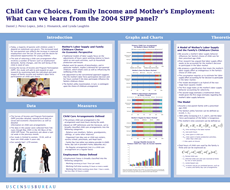Child Care Choices, Family Income and Mother’s Employment: What can we learn from the 2004 SIPP panel?
Child Care Choices, Family Income and Mother’s Employment: What can we learn from the 2004 SIPP panel?
Presented at the Annual Meeting of the Population Association of America, Washington, DC, March 31–April 2, 2011
Introduction
- Today, a majority of parents with children under 5 depend on substitute care givers. The increased need for non-parental care refl ects the increase in maternal employment over the last 30 years and the desire for educational opportunities for young children.
- The task of selecting a child care arrangement often involves a number of factors such as employment demands, family changes, and the well being of the child in need of care.
- Using the Survey of Income and Program Participation (SIPP), this study will add to and expand on past research by examining both the individual and joint impact of family income and mother’s labor force participation on child care choice.
Mother’s Labor Supply and Family Childcare Choice: An Economic Perspective
- Traditional models of labor supply focus on the adjustments of hours spent working relative to hours spent on non-work activities, such as household production and leisure
- Market work for parents of preschoolers, and in particular mothers, implies a demand for non-parental childcare, which entails costs as well as influencing the wellbeing of the child
- An adjustment to the conventional approach suggests that the mother’s labor force participation decision and her hours worked if she does participate influence the family’s childcare choice
- The family’s utility maximization, in turn, is contingent upon the choice of childcare arrangement
Page Last Revised - October 8, 2021




